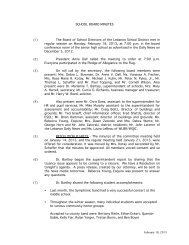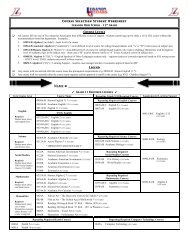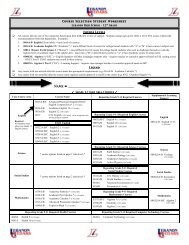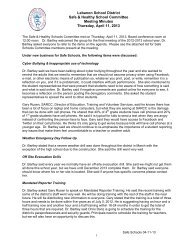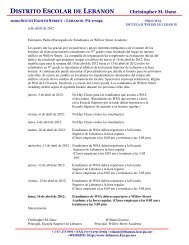Guide to Advising the College Bound Student âAthlete - Lebanon ...
Guide to Advising the College Bound Student âAthlete - Lebanon ...
Guide to Advising the College Bound Student âAthlete - Lebanon ...
Create successful ePaper yourself
Turn your PDF publications into a flip-book with our unique Google optimized e-Paper software.
GUIDE TO ADVISING THE COLLEGE BOUND STUDENT ATHLETE<br />
governing bodies<br />
Introduction<br />
Collegiate athletic programs are supervised and governed by three major governing bodies: The National Collegiate<br />
Athletic Association (NCAA), <strong>the</strong> National Association of Intercollegiate Athletics (NAIA), and <strong>the</strong> National Junior <strong>College</strong><br />
Athletic Association (NJCAA). Each has specific rules and regulations regarding athletic eligibility for <strong>the</strong> colleges under<br />
<strong>the</strong>ir supervision.<br />
NCAA<br />
The NCAA is <strong>the</strong> largest of <strong>the</strong> three organizations, consisting of approximately 1,200 member schools in three<br />
divisions.<br />
NCAA Division I<br />
✓ This is <strong>the</strong> highest level of intercollegiate athletics and includes many of <strong>the</strong> larger universities competing on television.<br />
Much emphasis is placed on <strong>the</strong> specta<strong>to</strong>r component of <strong>the</strong> sport.<br />
✓ Schools must sponsor at least 7 sports for men and 7 for women with 2 team sports for each gender.<br />
✓ Division I schools have <strong>the</strong> most stringent recruitment policies, must provide a minimum amount of financial aid <strong>to</strong><br />
students and, in general, offer a great amount of scholarship money.<br />
✓ <strong>College</strong>s that field football teams are fur<strong>the</strong>r classified as Football Bowl Subdivision (FBS) (formerly Division I-A) and<br />
Football Championship Subdivision (FCS) (formerly Division I-AA). The differences between <strong>the</strong>se levels are (1) <strong>the</strong><br />
quality and depth of talented athletes and (2) <strong>the</strong> philosophical/financial commitment a university makes <strong>to</strong> its athletic<br />
program. FBS teams have <strong>to</strong> meet minimum attendance requirements (17,000 people per home game or an average<br />
of 20,000 over 4 years). Athletes face an enormous time commitment with no real off-season.<br />
✓ Examples of Division I colleges in Pennsylvania are <strong>the</strong> main campuses of Penn State University, Pittsburgh University,<br />
and Temple University.<br />
✓ Examples of FCS football colleges in in Pennsylvania are Lehigh University, Bucknell University, and Villanova<br />
University.<br />
NCAA Division II<br />
✓ Division II must offer at least 4 sports (men & women) and are generally smaller than Division I schools.<br />
✓ There is no mandate regarding minimum amount of financial aid awarded, <strong>the</strong>refore, scholarship monies are generally<br />
less than Division I. Most athletes are awarded partial athletic scholarships.<br />
✓ Many students utilize a combination of scholarship money, grants, and student loans <strong>to</strong> fund <strong>the</strong>ir schooling.<br />
✓ A majority of Division II teams feature a number of local or in-state student athletes.<br />
✓ At <strong>the</strong> Division II level, students face a substantial time commitment <strong>to</strong> <strong>the</strong>ir sport. Though not as high profile and<br />
competitive as Division I, <strong>the</strong> level of play is excellent and are often accompanied by strong regional rivalries.<br />
✓ Examples of Division II colleges in Pennsylvania are all of those in <strong>the</strong> state university system: Millersville University,<br />
Kutz<strong>to</strong>wn University, West Chester University, Bloomsburg University, IUP, etc.<br />
NCAA Division III<br />
✓ Division III must offer at least 5 sports (men & women) and are generally smaller than Division I and Division II schools.<br />
However, this is level is composed of <strong>the</strong> largest <strong>to</strong>tal number of schools.<br />
✓ Division III athletes receive no athletic scholarships based on athletic ability. All financial aid must be merit (academic)<br />
or need (financial) based.<br />
✓ Emphasis is placed on academics and player participation ra<strong>the</strong>r than large specta<strong>to</strong>r involvement.<br />
✓ Generally, athletes compete because <strong>the</strong>y love <strong>the</strong>ir sport. They are highly skills and competitive, but <strong>the</strong> time<br />
commitment is not as huge as Division I and II. Emphasis is on regional and conference competition. Most athletes<br />
competing at this level were a minimum of all-county or all-league honorees.<br />
Page 10



